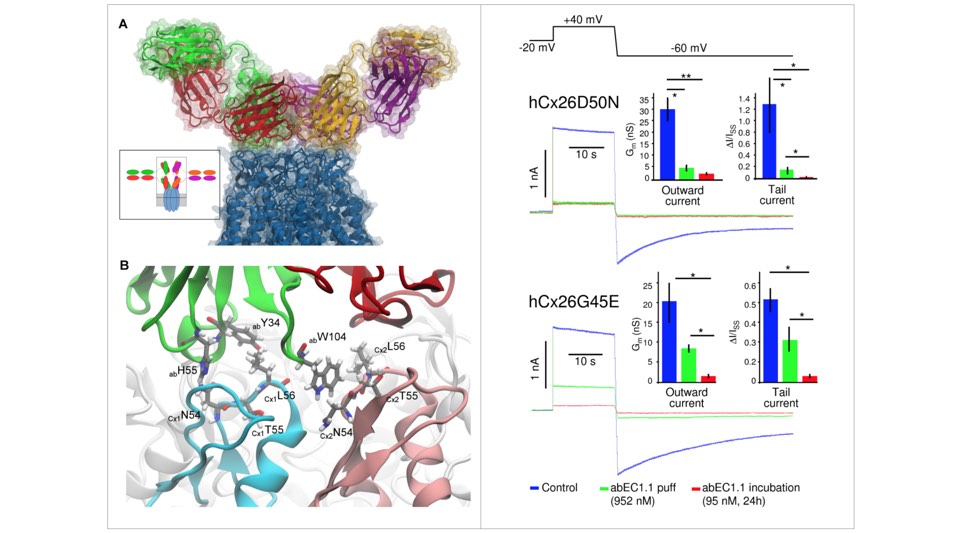Keracthitis � Ichtyosis � Deafness (KID) Syndrome, is a rare genetic disease, caused by mutations of GJB2 gene, which produce severe phenotypes in skin and inner ear. Connexin 26 (Cx26) proteins, encoded by GJB2, olygomerize to form gap junction channels, which allow direct communication between two cells, or connexin hemichannels, which function as regular membrane channels. Connexin hemichannels are normally close in physiological condition, but can open in response to a variety of electrochemical stimuli. Several point mutations of Cx26 that lead to KID syndrome have been shown to produce hemichannels which do not correctly close in physiological conditions (hyperactive hemichannels).
The SIAIS Phenotypic Screening lab of Prof. Guang Yang, in collaboration with Prof. Fabio Mammano (IBCN � CNR Italy and visiting professor in SIAIS), designed and characterized a human monoclonal antibody that interfere with hemichannels activity by occluding the extracellular mouth of the hemichannel. The antibody reduces the conductance of the hemichannels, and prevents the permeation of small molecules, such as ATP, both in wild type Cx26 and in two tested mutants which are related to the KID syndrome (D50N and G45E).
The antibody, entirely designed and characterized in SIAIS institute, is the first human monoclonal antibody which modulate the function of connexin hemichannels. Its discovery demonstrated the power of the library screening approach even for such challenging targets.
While more test are needed to prove the efficacy of the antibody also in vivo, these results provide a hope for the treatment of the severe skin phenotype of KID syndrome. The Phenotypic Screening Lab is already at work to test the results in mice model and verify whether this antibody is a good drug candidate.
The work has been financed by NSFC and Shanghaitech University. The main authors are Liang Xu SIAIS graduate student, Andrea Carrer from Padova University and Francesco Zonta SIAIS Associate Professor. The corresponding author is Fabio Mammano. The paper has just been published in Frontiers of Molecular Neuroscience.
Link to full paper: http://journal.frontiersin.org/article/10.3389/fnmol.2017.00298/full
Left: The docking model reveals the blocking mechanisms and the critical residues that are involved in the interaction between the antibody and the connexin hemichannel. Right: Electrophysiology experiments show that the antibody is effective at reducing the channel conductance in two mutants involved in KID syndrome (D50N and G45E) as well as in the wild type channel (data not shown).




